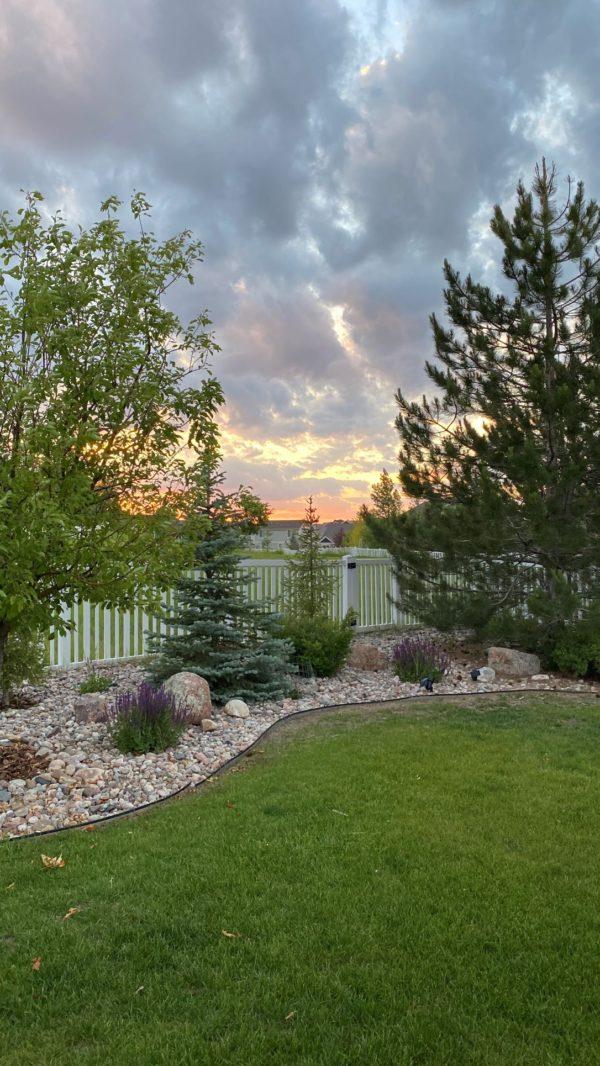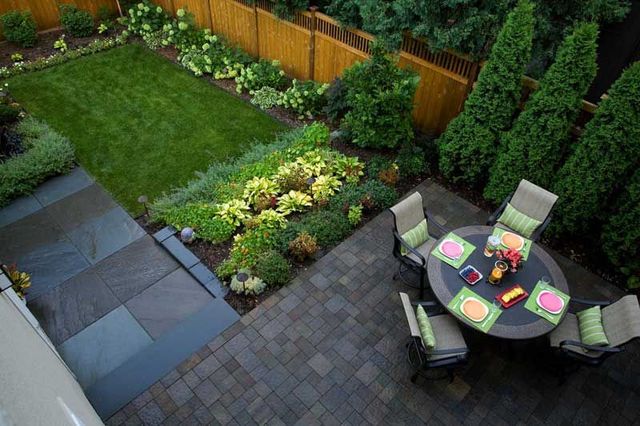7 Creative Retaining Wall Installation Ideas for Sloped Landscapes
Wiki Article
Checking Out Different Kinds of Landscaping to Enhance Your Outdoor Atmosphere
Landscape design plays a vital role in defining exterior rooms. Different designs, from standard yards to modern minimal layouts, provide distinct advantages for improving visual appeals and feature. Integrating aspects like xeriscaping and native plants can contribute to environmental balance. Comprehending the interplay of hardscape and softscape is important for developing welcoming settings. The selections readily available can be frustrating, prompting one to reflect on which style best aligns with their vision for an exterior sanctuary.Standard Garden Landscaping

While several modern-day yards embrace minimalism and native growings, conventional garden landscaping remains a valued approach that highlights balance, framework, and decorative attributes. This design typically includes formal geometric layouts, where flowerbeds, bushes, and paths are prepared with accuracy. Central focal factors, such as sculptures or fountains, attract the eye and offer a sense of harmony.Traditional landscaping regularly consists of a range of plant kinds, showcasing seasonal flowers and evergreen components. Traditional hedges, perennials, and annuals create vibrant shades and appearances throughout the year. Furthermore, arcs, trellises, and pergolas include upright passion and work as support for climbing plants, boosting the overall aesthetic.The use natural products, such as stone and timber, additional improves the typical landscape, adding to an ageless top quality. Inevitably, this style welcomes leisure and pleasure, making it a cherished choice for those seeking an attractive exterior environment.
Modern Minimalist Landscape Design
Modern minimalist landscaping highlights simpleness and functionality, characterized by tidy lines and open spaces. Secret qualities include a limited plant palette and thoughtful hardscape style that prioritizes functionality and visual allure. Effective plant choice strategies even more improve the minimalist approach, developing serene outside atmospheres that urge leisure and reflection.Secret Qualities of Minimalism
An expanding pattern in landscaping is the welcome of minimalism, identified by simplicity and performance. Minimalist landscaping concentrates on tidy lines, open rooms, and a minimal shade scheme, advertising a sense of tranquility. Components are thoroughly curated to stay clear of mess, permitting each element to stick out. Using all-natural materials, such as stone and timber, improves the organic feeling while preserving an aesthetic equilibrium. Furthermore, minimal styles commonly integrate geometric shapes, which can create aesthetic rate of interest without overwhelming the detects. Water functions might be included, working as centerpieces that boost tranquility. Generally, minimalism in landscape design stresses the appeal of restraint, allowing nature's fundamental top qualities to beam through in an unified outdoor atmosphere.Plant Selection Techniques
Reliable plant choice is crucial for accomplishing the preferred visual in modern minimalist landscape design. The focus must get on simpleness, making use of a minimal palette of plants that complement each various other and the surrounding atmosphere. Native plants are often suitable, as they need less upkeep and water, promoting sustainability. Picking species with varying structures and heights can include visual passion without frustrating the space. Organizing plants in collections instead than scattering them enhances communication and strengthens the minimal style. Evergreen varieties can supply year-round framework, while seasonal blooms introduce subtle shade changes. Ultimately, the objective is to produce a tranquil outdoor space that embodies serenity and consistency through thoughtful plant options.Hardscape Style Principles
Necessary components in hardscape layout considerably contribute to the overall visual appeals and capability of minimalist landscape design. This style approach emphasizes clean lines and downplayed products, producing an uncluttered visual experience. Key elements include paths, patio areas, and maintaining wall surfaces, which not just define rooms however likewise boost ease of access and functionality. The usage of materials such as concrete, rock, and timber is common, mirroring a natural yet modern-day aesthetic. Including geometric shapes and balanced layouts even more strengthens the minimal ideology, permitting for an unified blend with bordering plant. Furthermore, proper water drainage and disintegration control are important factors to consider, ensuring longevity and sustainability. Inevitably, effective hardscape design acts as a structure that matches softscape elements while maintaining equilibrium and simpleness in outside environments.
Cottage-Style Landscape design
Cottage-style landscape design uses a wonderful strategy to developing welcoming exterior rooms. By including enchanting plant mixes, this design cultivates a sense of warmth and whimsy. The focus on comfy, well-defined locations urges relaxation and enjoyment of nature.Charming Plant Mixes
Although many house owners seek to create an attractive outside space, achieving the beauty of cottage-style landscape design commonly depends upon thoughtful plant combinations. Vibrant blossoms, lush vegetation, and fragrant herbs can be artfully coupled to stimulate a feeling of whimsy and fond memories. Combining lavender, daisies, and foxgloves produces a vivid tapestry that brings in pollinators while providing a delightful scent. Incorporating decorative yards like miscanthus can include texture and activity, matching the softer flowers. Additionally, mixing seasonal and annual plants guarantees continual shade throughout the periods. Using climbers, such as clematis or honeysuckle, can boost vertical interest. In general, these combinations not just enhance the landscape however likewise cultivate a charming and inviting ambience.
Comfortable Outdoor Spaces
Producing comfy outdoor areas calls for a cautious mix of convenience and charm, complementing the dynamic plant combinations located in cottage-style landscape design - Landscape Lighting Installer. These areas typically feature welcoming seating plans, such as weather-beaten wooden benches or supported chairs surrounded by lavish plant. Soft lights, like fairy lights or lanterns, includes heat, transforming the space into a relaxing retreat. Integrating components such as trellises decorated with climbing roses or great smelling herbs improves sensory experiences. Furthermore, paths made from rustic rocks welcome exploration and connection with nature. Attractive touches like birdbaths or whimsical yard art contribute to a feeling of fancifulness. Inevitably, the objective is to develop an enchanting ambience that motivates relaxation and pleasure of the elegance bordering these comfortable outside sanctuariesXeriscaping for Water Preservation
Just how can areas balance aesthetic landscape design with the pressing demand for water conservation? Xeriscaping arises as a feasible solution, advertising sustainable practices that reduce water usage while enhancing outside appeal. This landscape design method concentrates on using drought-resistant plants belonging to the region, which call for substantially less water than standard yards. By integrating compost and effective irrigation systems, xeriscaping reduces evaporation and overflow, additional preserving priceless water resources.Communities can develop aesthetically attractive landscapes via mindful planning, choosing a diverse variety of appearances and shades that flourish in arid conditions. Additionally, xeriscaping encourages the usage of ornamental rocks and attractive crushed rock, offering eye-catching and practical options to grass yards. As communities welcome this environmentally friendly approach, they not only reduce their water consumption but also advertise biodiversity and resilience in their neighborhood communities. Inevitably, xeriscaping functions as a presentation of the harmony in between aesthetic charm and environmental duty.Hardscape Design Components
Hardscape design components play a necessary duty in enhancing outside rooms by supplying framework and performance. These non-plant attributes, such as patio areas, wall surfaces, walkways, and decks, produce visual interest while offering practical functions. Making use of products like concrete, block, and rock, hardscaping adds to the overall aesthetic charm and longevity of a landscape.Incorporating hardscape elements can specify areas within a backyard, guiding activity and encouraging social interaction. As an example, a well-placed path can attach different sections of the yard, while maintaining wall surfaces can handle elevation adjustments and protect against erosion.Furthermore, hardscape layout can boost accessibility and security, offering secure surfaces for strolling or relaxing. Effective assimilation of hardscape elements enhances soft landscape design, guaranteeing a well balanced outdoor atmosphere. Inevitably, thoughtful hardscape style enhances not just the charm of outside areas but likewise their usability, making them a lot more welcoming and practical for visitors and house owners alike.Outside Living Rooms
While outdoor home use a smooth mix of comfort and nature, they function as essential extensions of a home, enhancing lifestyle and recreation. These areas can consist of patio areas, decks, or outdoor kitchens, designed to promote relaxation and enjoyment. Grill Islands. By incorporating useful furniture and stylish style, homeowners develop welcoming ambiences for events or peaceful evenings.The combination of color structures, such as awnings or pergolas, protects against the aspects while keeping an open feel. Fire pits and outside heating systems extend functionality right into cooler months, supplying warmth and ambiance. Additionally, including lighting attributes enhances the area's functionality after sundown, producing a wonderful evening atmosphere.Landscaping components, such as pathways and borders, additionally define these areas, assisting motion and including aesthetic appeal. Inevitably, outside home transform yards into versatile retreats, promoting a way of life that embraces both nature and convenienceNative Plant Landscaping
Native plant landscape design highlights making use of aboriginal vegetation to produce lasting and harmonious exterior atmospheres. This technique not just improves biodiversity however additionally conserves water and lowers the need for chemical fertilizers and pesticides. By choosing plants that are indigenous to a certain region, property owners can ensure that their landscapes are well-adapted to regional soil and environment problems, leading to reduced maintenance requirements.Additionally, native plants offer crucial environments for neighborhood wild animals, consisting of bees, birds, and butterflies, promoting environmental wellness. Landscape develops that incorporate these plants typically feature naturalistic layouts that imitate neighborhood ecosystems, cultivating a local color and connection to the environment.Furthermore, indigenous plant landscape design can add to soil stability and erosion control, making it an eco accountable selection. In general, this technique not just improves outside areas but also supports the regional ecological community, creating a sustainable balance between human activity and nature.
Regularly Asked Inquiries
How Can I Choose the Right Landscaping Style for My Home?
Choosing the ideal landscape design design for a home involves examining the residential or commercial property's design, climate, and individual preferences. Outdoor Lighting Installer. Looking into numerous styles and consulting experts can give support to create an unified outdoor space tailored to private requirementsWhat Is the Average Expense of Expert Landscaping Providers?
The average expense of specialist landscaping services generally ranges from $1,000 to $5,000, relying on job place, dimension, and intricacy. Homeowners ought to take into consideration obtaining multiple quotes to assure they obtain fair rates and quality solution.Exactly how Typically Should I Preserve My Landscaped Yard?
The regularity of maintaining a landscaped backyard generally relies on the plants and functions existing. Typically, regular maintenance every few weeks is advised, with seasonal tasks Retaining Wall Installation enhancing in regularity during optimal growing seasons for perfect health and visual appeals.Exist Landscaping Options for Tiny Urban Spaces?

Numerous landscaping alternatives exist for small urban areas, including upright gardens, container plants, and rooftop yards. Including these elements can optimize limited locations while providing greenery, improving aesthetics, and enhancing air top quality in metropolitan settings.
What Plants Are Best for Drawing In Regional Wildlife?
The most effective plants for attracting local wild animals consist of native blooming varieties, berry-producing hedges, and diverse yards. These plants offer necessary food and habitat, promoting a flourishing ecosystem that sustains various birds, insects, and small animals. Several home owners look for to produce an attractive outdoor room, accomplishing the charm of cottage-style landscape design often pivots on thoughtful plant mixes. Developing cozy outdoor areas needs a careful mix of convenience and appeal, matching the dynamic plant combinations discovered in cottage-style landscaping. Indigenous plant landscape design stresses the usage of aboriginal flora to develop unified and lasting outside atmospheres. Landscape makes that incorporate these plants usually include naturalistic layouts that imitate local communities, fostering a sense of area and link to the environment.Furthermore, native plant landscaping can contribute to soil security and disintegration control, making it an environmentally responsible selection. Different landscaping alternatives exist for tiny metropolitan rooms, consisting of vertical gardens, container plants, and rooftop gardens.Report this wiki page